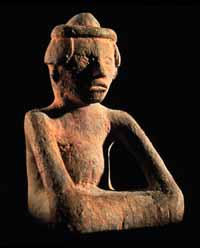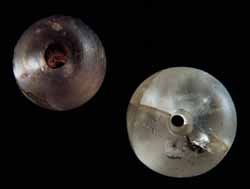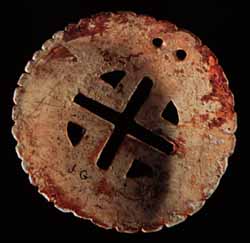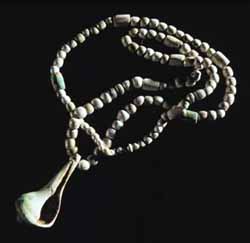
 |
Stone figurine, Kincaid site, Massac County. | |
|
Material used for clothing-animal hide and plant fiber-are rarely preserved in the ground. Archaeologists learn about apparel by studying figurines and other artifacts, but interpreting them is difficult. Is this man wearing a hat with a pointed crown, head band, and ear coverings or is the top of his head shaved and the long hair on the side of his head held in place by a head band? |
||
Mississippian people left behind a variety of objects that provide clues about their appearance. For example, carved stone human figures and detailed engravings on marine shells depict warriors, leaders, religious figures, and even deceased members of a community. These images show different types of clothing, hairstyles, and ornaments. Some men appear to be wearing clothing similar to kilts. Men's hair styles include forelocks, buns, knots, and roaches.
Some of the men appear to have tattoos consisting of fine geometric designs that sometimes cover much of the body.
 |
Stone beads, Cass and Peoria counties. | |
|
Native Americans made beads out of a variety of material including bone, shell, and stone. The bead on the left is made of fluorite; the bead on the right is made of crystal. Native American artisans shaped a rough piece of stone by grinding away unwanted material with sandstone or another abrasive material. Next, they drilled a hole with a stone drill, perhaps using fine sand to aid in the process. Strings of beads were worn around the neck, wrists, and ankles. |
||
Other than these few examples that tell us what Mississippians looked like, archaeologists have found few examples of clothing in Illinois. As noted elsewhere in this module, materials used for clothing-hides and fiber-deteriorated quickly after burial and are rarely preserved. The only apparel items consistently preserved are things made of stone, bone, pottery, or some other durable material.
 |
Shell gorget, J. Gilette site, Schuyler County. | |
|
A gorget is an ornament worn on a necklace. This gorget is made of freshwater mussel shell (marine shell?). Using a stone tool, a Native American cut out a disk-shaped piece of shell, notched the edges in a regular interval, cut out the cross-shaped and triangular openings, and then drilled two holes through which they strung a cord of rawhide or plant fiber. The design may be an abstract circle-and-cross design, which is sometimes interpreted as the annual renewal of Mississippian life. |
||
Mississippian ornaments include gorgets, ear spools, and necklaces of fresh water and/or marine shell beads.
 |
Pearl and marine shell necklace, Vandeventer site, Brown County. | |
|
This necklace is a combination of a marine Busycon ? shell, tubular beads made from marine shell, and freshwater pearls, all of which would have been rare and thus, valuable. Mississippians probably acquired marine shell through a trade network that reached the Gulf of Mexico and the Atlantic Ocean. |
||
|
|
Copyright © 2000 Illinois State Museum